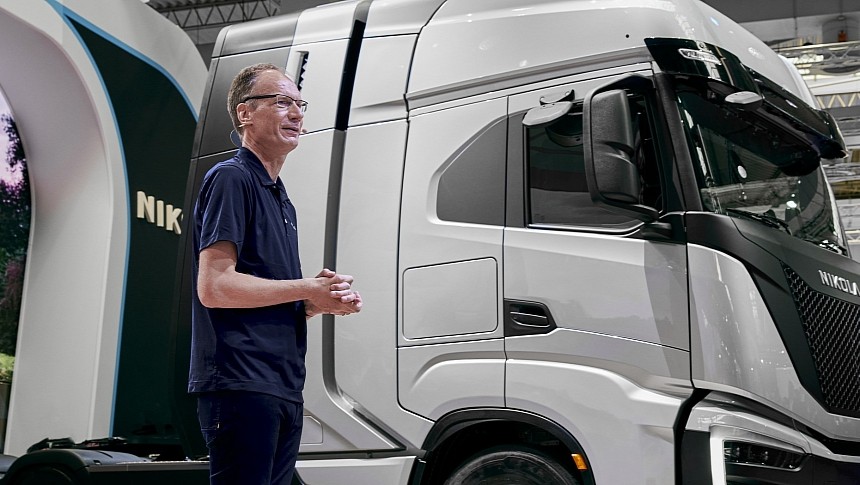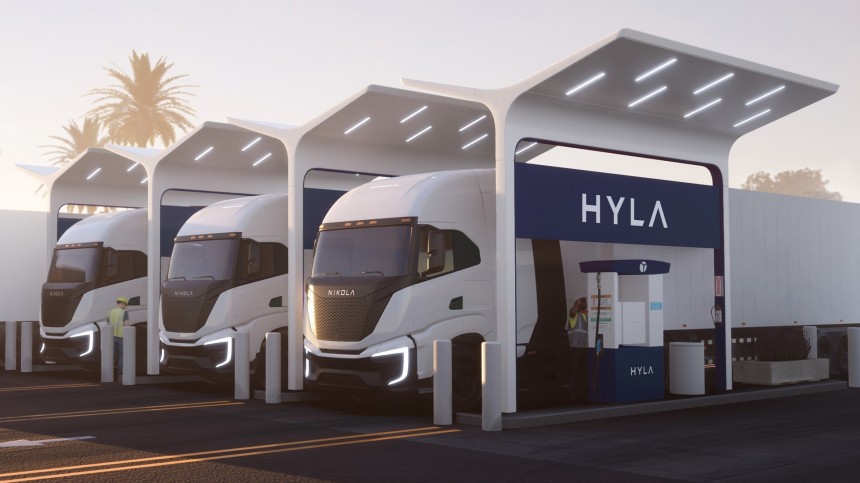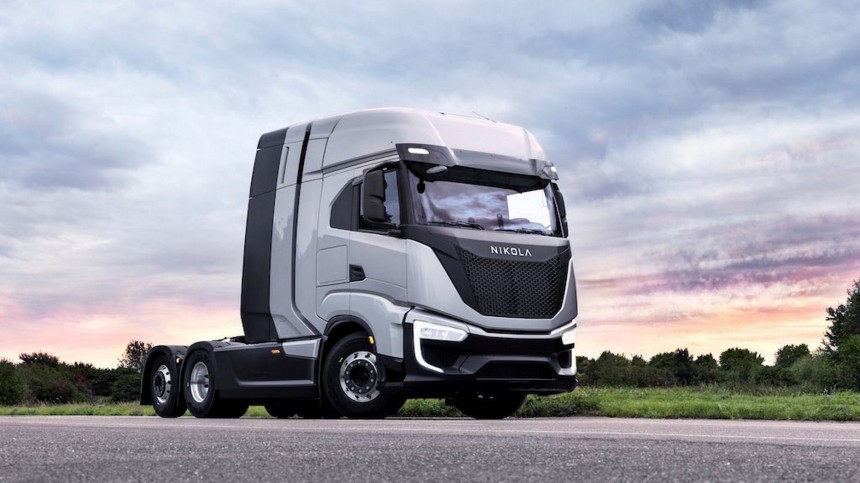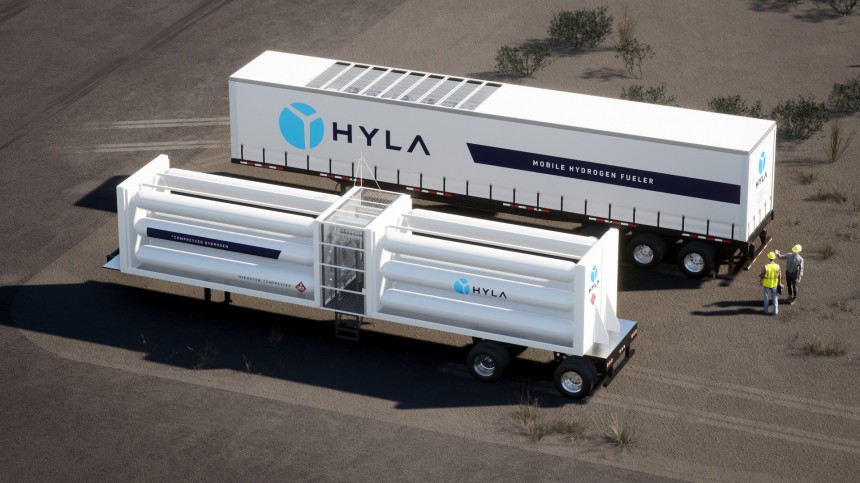Nikola had the help of Biagi Bros to validate its fuel cell truck. Things have apparently gone well enough for series production to start on July 31. Customers will receive the first Tre FCEV units in September. Too bad that Michael Lohscheller will just watch that from a distance: he is no longer Nikola's CEO.
In a surprising move, the former Opel and VinFast CEO asked to leave "due to a family health matter" and has returned to Europe. Something similar happened when he was with the Vietnamese battery electric vehicle (BEV) automaker. Lohscheller was replaced by Steve Girsky, who was the chairman of the board of directors and was crucial in sealing the deals Nikola had with General Motors.
As you may recall, the American automaker would manufacture Nikola's pickup truck – called Badger. After Hindenburg Research exposed several problems with the truck startup, GM was accused of validating Nikola without due diligence. The American automaker backtracked most deals it had with the truck startup and said it would sell Nikola its fuel cells. The production truck uses components from Bosch.
Nikola seems grateful for Lohscheller's work. The German executive probably helped Nikola realize it did not have money to do everything it wanted. The company presented the sale of the Phoenix Hydrogen Hub and the focus on the American market as major wins. Still, they sound more like sensible cost-cutting measures aimed at making the company financially healthy in its home market. Detractors may see that as an involuntary retraction, but it makes perfect sense: you should only think about expanding abroad with a robust domestic operation.
Lohscheller introduced HYLA, the hydrogen division that will make the fuel cell trucks feasible. At first, Nikola wanted to sell the vehicles and make the "fuel" they would need, but the plans changed radically. Hydrogen production will be entirely in the hands of partners. As long as Nikola is confident that it can get reasonable prices for the gas – particularly its green type – that should not be an issue. The challenge is keeping the cost per mile as low as possible with fuel cell trucks. Maintenance should also be lower than that for a diesel truck.
According to Nikola, 18 customers ordered 200 units of the Tre FCEV. They have probably tried the ten Gamma trucks the company used to validate the production units that started leaving assembly lines on July 31. Nikola said these prototypes will still be used, but it does not make sense when it has already begun mass production. At best, these trucks may help anticipate problems with the production vehicles and even trigger recalls. If you have seen the pictures of the trucks the Biagi Bros tested, forget them: the vehicles customers will receive will be similar to the Tre FCEV Beta first presented at the IAA 2022.
To help these fuel cell trucks run, Nikola will deploy nine HYLA hydrogen mobile fuelers at several locations in California until the end of the year. The company also has a partnership with Voltera to create eight hydrogen stations. The first one will be in Ontario, California, and it is expected to start operations by the end of 2023. Apart from relying on "well-capitalized partners" that align with Nikola's "capital-efficient strategy," the truck maker also secured $50 million in "grant funding from various California agencies, reducing the capital costs for hydrogen stations."
There's a more straightforward way to frame the arrangement Nikola made with its partners: the truck startup ensured they would have demand for their hydrogen stations. The biggest problem with fuel cell vehicles was this "chicken or the egg" dilemma: carmakers would not make FCEVs because their clients would have nowhere to buy hydrogen, and energy companies were afraid to build hydrogen stations that no one would use.
Nikola also sells battery electric trucks (BETs) but had a significant problem with them recently. On June 23, five Tre BEV trucks caught fire at the factory in Phoenix. Nikola quickly said it suspected foul play. However, Electrek discovered that the battery packs made by Romeo Power had cells that corroded and self-discharged. Nikola bought Romeo Power last year. This issue could have caused the fires, but the truck startup denied using defective modules in production vehicles. It said it is still investigating what caused the blaze, which could take weeks. Nikola would better rush these investigations. Luckily, the fire happened with trucks that had not reached their buyers yet. What if any of these vehicles were on a highway carrying a hazardous load, for example?
The risk of thermal runaway adds to the disadvantages that BETs have even if nothing goes wrong. The higher mass turned into a massive government cheating that increases the maximum gross weight of these trucks, something that may hurt road conservation. However, that does not address the wait times these massive battery packs will impose when they need to be fast charged. On top of that, these components will need to be replaced sooner after constant fast-charging sessions. The apparently lower operation costs will really reveal themselves in the long run.
At least Nikola is pursuing a more sensible option for trucks with fuel cells and hydrogen. Hopefully, its well-capitalized partners will create a hydrogen network that sells the gas at a price that doesn't hurt cargo costs. If they manage to pull that off, we may finally cut a larger share of the 15% share of total carbon emissions attributable to the transportation sector. If only climate change activists cared about the other 85% with the same enthusiasm...
As you may recall, the American automaker would manufacture Nikola's pickup truck – called Badger. After Hindenburg Research exposed several problems with the truck startup, GM was accused of validating Nikola without due diligence. The American automaker backtracked most deals it had with the truck startup and said it would sell Nikola its fuel cells. The production truck uses components from Bosch.
Nikola seems grateful for Lohscheller's work. The German executive probably helped Nikola realize it did not have money to do everything it wanted. The company presented the sale of the Phoenix Hydrogen Hub and the focus on the American market as major wins. Still, they sound more like sensible cost-cutting measures aimed at making the company financially healthy in its home market. Detractors may see that as an involuntary retraction, but it makes perfect sense: you should only think about expanding abroad with a robust domestic operation.
According to Nikola, 18 customers ordered 200 units of the Tre FCEV. They have probably tried the ten Gamma trucks the company used to validate the production units that started leaving assembly lines on July 31. Nikola said these prototypes will still be used, but it does not make sense when it has already begun mass production. At best, these trucks may help anticipate problems with the production vehicles and even trigger recalls. If you have seen the pictures of the trucks the Biagi Bros tested, forget them: the vehicles customers will receive will be similar to the Tre FCEV Beta first presented at the IAA 2022.
To help these fuel cell trucks run, Nikola will deploy nine HYLA hydrogen mobile fuelers at several locations in California until the end of the year. The company also has a partnership with Voltera to create eight hydrogen stations. The first one will be in Ontario, California, and it is expected to start operations by the end of 2023. Apart from relying on "well-capitalized partners" that align with Nikola's "capital-efficient strategy," the truck maker also secured $50 million in "grant funding from various California agencies, reducing the capital costs for hydrogen stations."
Nikola also sells battery electric trucks (BETs) but had a significant problem with them recently. On June 23, five Tre BEV trucks caught fire at the factory in Phoenix. Nikola quickly said it suspected foul play. However, Electrek discovered that the battery packs made by Romeo Power had cells that corroded and self-discharged. Nikola bought Romeo Power last year. This issue could have caused the fires, but the truck startup denied using defective modules in production vehicles. It said it is still investigating what caused the blaze, which could take weeks. Nikola would better rush these investigations. Luckily, the fire happened with trucks that had not reached their buyers yet. What if any of these vehicles were on a highway carrying a hazardous load, for example?
At least Nikola is pursuing a more sensible option for trucks with fuel cells and hydrogen. Hopefully, its well-capitalized partners will create a hydrogen network that sells the gas at a price that doesn't hurt cargo costs. If they manage to pull that off, we may finally cut a larger share of the 15% share of total carbon emissions attributable to the transportation sector. If only climate change activists cared about the other 85% with the same enthusiasm...















